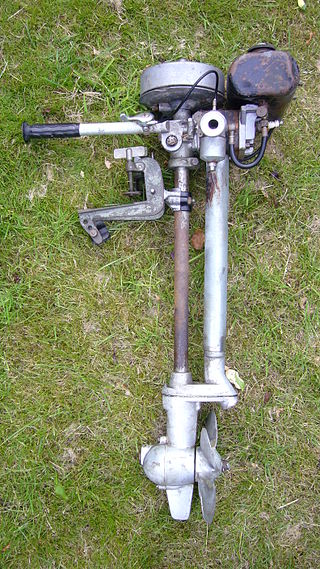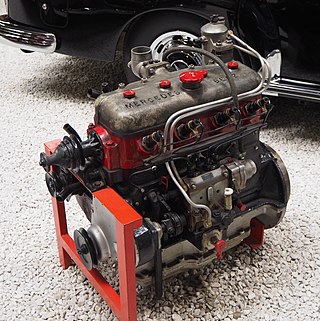
An outboard motor is a propulsion system for boats, consisting of a self-contained unit that includes engine, gearbox and propeller or jet drive, designed to be affixed to the outside of the transom. They are the most common motorised method of propelling small watercraft. As well as providing propulsion, outboards provide steering control, as they are designed to pivot over their mountings and thus control the direction of thrust. The skeg also acts as a rudder when the engine is not running. Unlike inboard motors, outboard motors can be easily removed for storage or repairs.

An opposed-piston engine is a piston engine in which each cylinder has a piston at both ends, and no cylinder head. Petrol and diesel opposed-piston engines have been used mostly in large-scale applications such as ships, military tanks, and factories. Current manufacturers of opposed-piston engines include Cummins, Achates Power and Fairbanks-Morse Defense (FMDefense).

Power Stroke, also known as Powerstroke or PowerStroke, is the name used by a family of diesel engines for trucks produced by Ford Motor Company and Navistar International for Ford products since 1994. Along with its use in the Ford F-Series, applications include the Ford E-Series, Ford Excursion, and Ford LCF commercial truck. The name was also used for a diesel engine used in South American production of the Ford Ranger.

A crankcase is the housing in a piston engine that surrounds the crankshaft. In most modern engines, the crankcase is integrated into the engine block.

British Seagull was a British manufacturer of simple and rugged two-stroke marine outboard motors, produced from the late 1930s until the mid-1990s. Originally based in based in Wolverhampton, the company moved to Poole, Dorset, a centre for boating and yachting. Seagull engines were utilitarian outboards with a relatively slow-turning prop. Tthey were ideal for use in dinghies, tenders and small yachts, but were unsuited for high-speed craft.

The hot-bulb engine, also known as a semi-diesel, is a type of internal combustion engine in which fuel ignites by coming in contact with a red-hot metal surface inside a bulb, followed by the introduction of air (oxygen) compressed into the hot-bulb chamber by the rising piston. There is some ignition when the fuel is introduced, but it quickly uses up the available oxygen in the bulb. Vigorous ignition takes place only when sufficient oxygen is supplied to the hot-bulb chamber on the compression stroke of the engine.

An inboard motor is a marine propulsion system for boats. As opposed to an outboard motor where an engine is mounted outside the hull of the craft, an inboard motor is an engine enclosed within the hull of the boat, usually connected to a propulsion screw by a driveshaft.

The Volvo D5 is a type of turbocharged diesel engine developed by Volvo Cars for use in its passenger cars. The D5 engine is based on the Volvo Modular diesel engine. The D5 displaces 2.4 liters; a smaller series of two-litre engines were developed in 2010 and marketed as the Volvo D3 and D4.

The Detroit Diesel Series 71 is a two-stroke diesel engine series, available in both inline and V configurations, manufactured by Detroit Diesel. The number 71 refers to the nominal displacement per cylinder in cubic inches, a rounding off of 70.93 cu in (1.2 L).
The Detroit Diesel 149 is a series of two-stroke diesel engines manufactured by Detroit Diesel which were first announced in early 1966. After Detroit Diesel was spun off in 1988 and later acquired by MTU, production of Series 149 engines was discontinued around 2000.

Wärtsilä Vasa is an engine series built by Finnish diesel engine manufacturer Wärtsilä. It was released in 1977 and remained in production until 2010. These medium speed diesels were produced in and named after Vasa, Finland. The lead designer of the first engine was Wilmer Wahlstedt. The series comprises three models, the Vasa 22, 32, and 46, with the number denoting the bore size of the engine.

An internal combustion engine is a heat engine in which the combustion of a fuel occurs with an oxidizer in a combustion chamber that is an integral part of the working fluid flow circuit. In an internal combustion engine, the expansion of the high-temperature and high-pressure gases produced by combustion applies direct force to some component of the engine. The force is typically applied to pistons, turbine blades, a rotor, or a nozzle. This force moves the component over a distance. This process transforms chemical energy into kinetic energy which is used to propel, move or power whatever the engine is attached to.

Motorenfabrik Hatz is a German manufacturer of diesel engines, based in Ruhstorf an der Rott, Lower Bavaria, Germany. Especially known for its small, lightweight and robust engines, the engines are mainly used in all kinds of small construction machinery, for generators or pumps

The MWM AKD 112 Z is an air-cooled two-cylinder inline diesel engine produced by MWM from 1955 – 1960. One, three and four cylinder variants of the same engine family were also produced by MWM.

The 4 VD 14,5/12-1 SRW is an inline four-cylinder diesel engine produced by the VEB IFA Motorenwerke Nordhausen from 1967 to 1990. The engine was one of the standard modular engines for agricultural and industrial use in the Comecon-countries. Approximately one million units were made.

The Mercedes-Benz OM 138 is a diesel engine manufactured by Daimler-Benz. In total, 5,719 units were produced between 1935 and 1940. It was the first diesel engine especially developed and made for a passenger car. The first vehicle powered by the OM 138 was the Mercedes-Benz W 138. The light Mercedes-Benz trucks L 1100 and L 1500 as well as the bus O 1500 were also offered with the OM 138 as an alternative to the standard Otto engine.

The Volkswagen-Audi V8 engine family is a series of mechanically similar, gasoline-powered and diesel-powered, V-8, internal combustion piston engines, developed and produced by the Volkswagen Group, in partnership with Audi, since 1988. They have been used in various Volkswagen Group models, and by numerous Volkswagen-owned companies. The first spark-ignition gasoline V-8 engine configuration was used in the 1988 Audi V8 model; and the first compression-ignition diesel V8 engine configuration was used in the 1999 Audi A8 3.3 TDI Quattro. The V8 gasoline and diesel engines have been used in most Audi, Volkswagen, Porsche, Bentley, and Lamborghini models ever since. The larger-displacement diesel V8 engine configuration has also been used in various Scania commercial vehicles; such as in trucks, buses, and marine (boat) applications.























